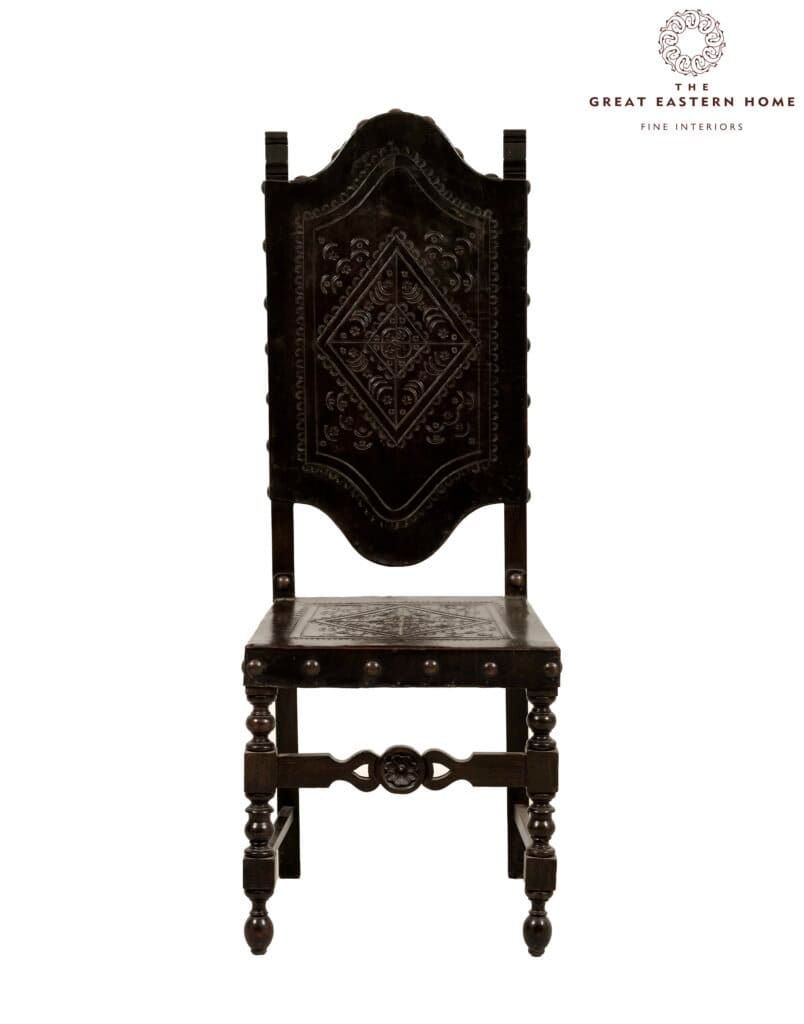Products Descritpion

- This beautiful Portuguese embossed leather armchair circa late 18th/early 19th century features a shaped triple scalloped crest. The leatherback and seat are embossed with foliates, and acanthine leaves flanked by bird motifs. Large brass nail-heads are used to hold the leather in place. The ears at the ends of the crest rail too are topped with metal finials. The front stretcher is entirely carved with an elaborately rolling scroll whilst simple blocks and turnings are used for all the four legs and balance stretchers. Note the hint of a claw foot on the front of the chair.

2.Carved in exotic Brasil Redwood, this chair has a symmetrical leather back with a simple curving crest rail. This early 19th-century side chair has a simply embossed leather back and seat. The front legs are partly turned and are joined with a stretcher with a carved floral motif. Large brass studs add to the beauty of the chair.

3 This triple crested leather side chair from the early 19th century uses both small and large brass nail heads around its embossed leather back and eats. The ears of the top crest rail are topped with delicate metal finials. The leather is decorated and tooled all over. The seat back shows scrolling foliage surrounding an emblematic lion that stands on both legs as it roars with its tongue furiously about. The legs of the chair are made using the block and turn method. The front stretcher stands out as the two intertwining curved scrolls connect both the front feet.
- This chestnut high back side chair has a symmetrical leather back with a simple curving crest rail. This early/mid-19th century side chair has a richly embossed leather back and seat.
The front legs are partly turned and are joined with a stretcher and a carved flower cartouche
in the centre. Large brass studs add to the beauty of the chair. The rear posts extend beyond
the crest rail as finials adding to the tall look of the chair - This single drawer Portuguese baroque sideboard is made of chestnut wood. Profusely decorated all over, this late 18 th century piece rests on an elaborately carved base. The front two openable panels have exuberant scrolls of foliage emerging from the backs of a pair of birds; almost making them look like stylized peacocks. The foliage undulates freely and is adorned with leaves, buds and even grapes. Two solemn faces with seeing eyes draw attention. The two fixed panels in front are also carved. The rising foliage supports a typical Baroque urn. The side panels and the drawer panels too feature scrolling leaves and flowers.
- This walnut wood bar cabinet from the late 18th century rests on elegant baluster-shaped turned legs. The interior of the cabinet is lined with mirrors and brass hooks for holding glasses. The front panel of the cabinet has stepped diamond-shaped carvings, the simplicity of which has a beautiful counterpoint in the curved apron front. Two large decorative brass hinges and brass pulls add to the charm of the piece.
- A Portuguese chest from the early 19th century has touches of the neoclassical in it. Made from chestnut wood, the base is decorated with egg and dart motifs.
The two drawers at the bottom have elaborate brass escutcheons. The main parts of the chest are adorned with stepped diamond shapes surrounded by triangular-shaped pyramids. The diamond shapes too are highlighted by brass decorative.
This is a fine example of a chest finished with finely carved mouldings and a prominent brass escutcheon and handle. - This late 18th century Portugal writing desk made of mahogany wood has truly lovely turned legs. The legs terminate as solid arched ends highlighting the slenderness of the legs themselves. The turned legs of baluster shapes interspersed with rounds and turned plates also stand as a lively relief to the solidness of the rest of the desk. The crowning glory of this piece are surely the two wooden finials rising playfully from the stretcher and footrest connecting the legs.
- This early/ mid-19th century Portuguese cabinet made of mahogany uses repetitive geometric designs to great effect. The panels of the two shelves and two drawers are carved with symmetrical regular shapes which step up giving a great sense of depth. Resting on ball feet the frame of the cabinet has repeating and linked carved roundels. The top pediment has a series of arches. Keyholes are highlighted with metal escutcheons. Decorative metal pulls and hinges stand out against the polished woodwork.
Price: On Request
Website: http://www.thegreateasternhome.com/

